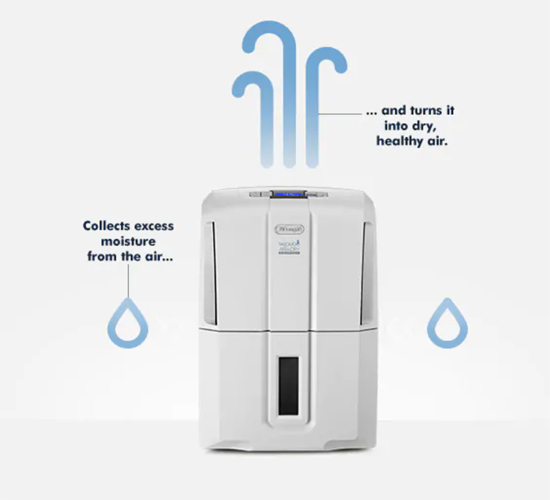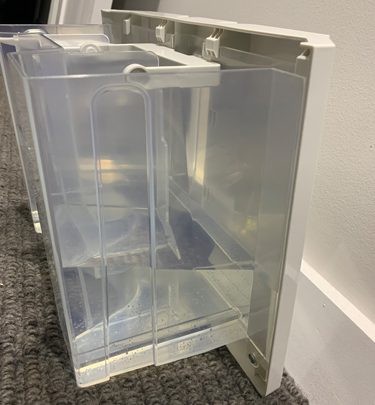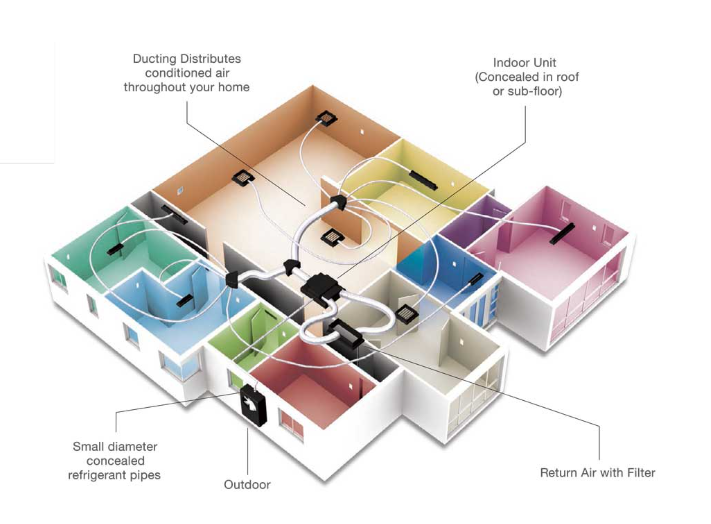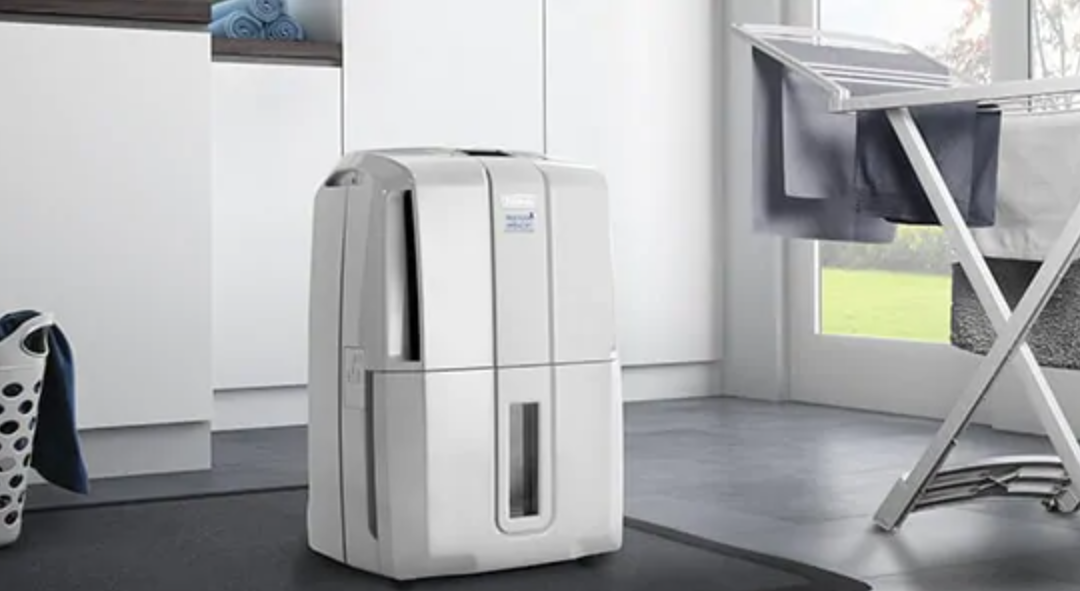I’m born and bred in Sydney, so am used to the humidity but it wasn’t until I spent a significant amount of time away from here, that I realised how much better it was without it (both house, and hair wise!) so, I added it to my list of things to look into and am now reporting back as it seems that I’m far from the only one interested!
If your house is damp, then a dehumidifier could be an affordable and easy solution to rid your house of its dampness. Whether it is a humid summer or a cold wet winter, dampness can be a major problem in your home. It’s unhealthy, uncomfortable, creates mould, dust mites, condensation and can stain or even ruin your paint. A dehumidifier could be a solution if your damp issues are not too significant. Some houses however, may require a more extensive problem solver so keep reading if that’s you as I’ve got you covered too.
Mould is not healthy and not something anyone should ignore. The following information is all based on my experience with my De’Longhi DD series dehumidifier and also information I have researched from the De’Longhi website and other online sources.
WHAT DOES A DEHUMIDIFIER DO?
A dehumidifier essentially removes moisture from the air, helping to prevent condensation and in turn, mould.
HOW DO I KNOW IF I NEED A DEHUMIDIFIER?
This is not a straightforward question as not all damp issues are caused by too much moisture in the air. Some symptoms that might indicate you have an issue could be;
Condensation on windows, stains on walls and ceilings, mouldy bathroom or shoes and clothes, musty smells, Black/dark specks on walls ceilings that grow over time, allergic reactions or ongoing allergies.
De’Longhi produce dehumidifiers that operate on one of two operating principles, Refrigerant or Dessicant
- Refrigerant types draw air into the machine from all over the house (providing there is free air flow i.e. doors open). Water is removed from the air by passing over a refrigerated evaporator and the warm dry air is released to the atmosphere.
- The desiccant dehumidification process uses a special humidity-absorbing material (known as a desiccant) to extract moisture from the air passed against it. The now saturated material then passes to a different position where the saturation is driven off by heating. To achieve this, DeLonghi desiccant types set the absorbing material within a large slowly rotating wheel, passing the separate de-humidifying and drying stages as a continual cycle.
A dehumidifier is most effective at warmer temperatures and higher relative humidity levels. Relative humidity levels above 60% can cause mould or mildew to grow, resulting in musty smelling air and unhealthy airborne mould spores. Studies have shown that a comfortable level of relative humidity is between 40% – 60%.


CAN A DEHUMIDIFIER DRY CLOTHES?
There are many reasons why your home may have excess moisture and drying cloths indoors is one of those, especially at this time of year
Wet clothes still have water in them after coming out of the washing machine and for those clothes to dry, that water comes out of the clothes and into the air. A clothes dryer dries clothes by evaporating the water using heat and blowing that water filled air into your home.
When that warm humid air touches a cool surface such as a wall, you would have seen that the water condenses. A dehumidifier will help to dry your clothes but instead of distributing all that water throughout your home it collects the water so it can be poured away or used on your plants.
ARE THEY EFFICIENT TO RUN?
Dehumidifiers use very little electricity in comparison to many other household appliances and to the above point, a fraction of the electricity that a clothes dryer may use to run.
De’Longhi dehumidifiers use less than 250W of power on a maximum setting.
In-built or automatic humidistat:
With this, the dehumidifier monitors the moisture in the air, usually so it can turn itself on and off to maintain the humidity level you’ve selected. The humidistat lets you set a target relative humidity for the room (basically, that’s the amount of water in the air for a given temperature). Depending on the model, this might be a precise number setting, or it might just offer a few basic settings such as low, medium and high.
Ideal relative humidity for human comfort is in the 40–60% range, but you might try as low as 30% if you prefer a dryer feeling, or up to 70% for more humidity.
All De’Longhi models have a humidistat that allows you to set the degree of relative humidity that you feel most comfortable with. The humidistat will switch the machine on and off accordingly to maintain the desired humidity level. Humidistats also help save on running costs as you do not need to have it running on full power all the time.
Portability
Dehumidifiers can be heavy and awkward so any features that help mobility are essential. I easily roll mine from room to room and can also carry it upstairs.
Tank
A small water-collection tank makes a dehumidifier more compact and easier to carry around – but if the tank is too small, you may have to empty it several times a day. Models with larger tanks won’t need to be emptied as often but can be bulkier. The tank should be easy to remove, and big enough to hold at least four litres of water.
Continuous drain
Useful if the dehumidifier will be run for long periods in the same location and you don’t want to empty the tank regularly. This feature allows you to connect a hose to the dehumidifier and flush collected water directly away to a low-level drain. Some come with an adaptor hose to pour the collected water straight down a drain.
Filter
All the tested models have an air filter for trapping dust, and some models have a UV light filter for killing airborne bacteria.
Timer?
Some models of dehumidifiers have a timer. As DeLonghi dehumidifiers are fitted with a humidistat that automatically turns the unit on and off as required there is really no advantage of having a timer.
ARE DEHUMIDIFIERS NOISY?
Most dehumidifiers make upward of 50 decibels (dB) of noise – which is essentially enough to be annoying if you’re trying to watch TV, hold a conversation or sleep. I must say that I prefer to have mine on when I’m out, or in a different part of the house as the noise is louder than I anticipated. The water that I collect at the end more than makes up for it though!
If you can, try to get the retailer to turn the unit on so you can hear the noise before you buy.
HOW MUCH DO DEHUMIDIFIERS COST?
Depending on the size, brand and type, dehumidifiers can range from $200 up to $1000
WHAT IF YOUR ISSUE IS BIGGER OR YOU’VE TRIED DAMP RID & DEHUMIDIFIERS?

The three most common kinds of damp are rising damp, penetrating damp and condensation. To work out the best way to treat the damp in your home, you’ll need to work out which of these you have. Our Trade Directory member, Xchange Air are experts in complete home ventilation solutions, sub floor damp, mould and condensation control.
If you’re sick of spending a fortune on damp absorbers, currently using dehumidifiers only to still have pesky mould spreading across your walls and ceilings, or feel that a dehumidifier isn’t necessarily big enough to fix your problem, get in touch with Michie, Martin and the team at Xchange air who can guide you in the right direction.
Xchange Air are a local, family run business. Martin has been in the home ventilation industry since 1997 and has built this cutting edge professional business through his in depth knowledge of the industry, his honesty, integrity, using only top quality products and recruiting only the very best to join his team in sales, admin and installation.
Xchange Air installs the quietest, most up to date innovate & energy efficient products. They install home ventilation products ranging from mechanical sub floor ventilation systems which provides a permanent solution for damp, musty smells and mould issues through to our full home ventilation systems which deal with removing condensation from your home by inputting dry, fresh filtered air.
Xchange Air offer a Full Free Home Assessment
Xchange Air ensure to get under EVERY house’s sub floor when quoting on sub floor ventilation or up into every roof when quoting on roof ventilation to ensure we know exactly what is needed to provide the best ventilation solution for your home. Many other Ventilation Companies when quoting do not get under your house or up in your roof space! This is vital to quote accurately and correctly and ensure your problem is resolved.
Xchange Air are licensed designers and installers of sub floor and roof ventilation systems. (Lic. No 182572C). They have inspected over 100,000 homes in NSW and have a full range of ventilation products and services to meet your needs.


